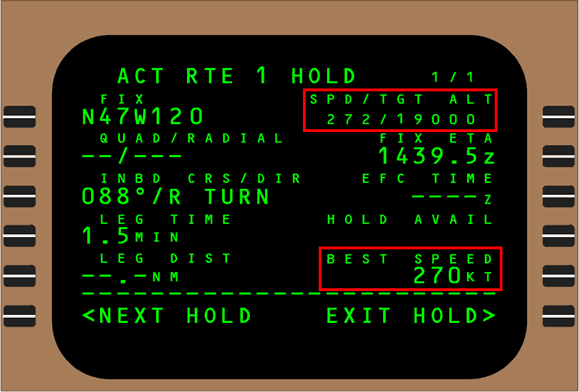Monday Accidents & Lessons Learned: Balancing Competing Attention or Decision Demands Can Interrupt Trained Flight Crew Responses

Example of the FMC route hold page with the target speed and the best speed highlighted. Source: Operator, annotated by ATSB
On April 7, 2017, a Qantas Airways Boeing 747-438, registered VH-OJU, operated scheduled passenger flight QF29 from Melbourne, Victoria, to Hong Kong International Airport, in the Hong Kong Special Administrative Region of the People’s Republic of China. On board were 17 crew and 347 passengers. The captain operated as pilot flying and the first officer as pilot monitoring.
While descending toward Hong Kong, air traffic control instructed the flight crew to hold at a waypoint. When entering the holding pattern, the aircraft’s aerodynamic stall warning stick shaker activated a number of times and the aircraft experienced multiple oscillations of pitch angle and vertical acceleration.
At 5:45 a.m., the aircraft descended toward waypoint BETTY (see diagram below), with the autopilot engaged in lateral navigation (LNAV) and vertical navigation (VNAV) modes, and the auto throttle engaged. As the aircraft descended from flight level (FL) 300, the customer service manager (CSM)—following direction from the flight crew—advised the passengers to prepare for landing and fasten seatbelts. However, at this time, the fasten seatbelt sign was not illuminated.

The figure above shows the position of the BETTY hold along with the inbound track of VH-OJU. Source: Hong Kong CAD, annotated by ATSB
During the upset, some passengers and cabin crew members struck the cabin ceiling and furnishings, sustaining minor injuries.
The ATSB (Australian Transport Safety Bureau) found that while planning for the descent, the flight crew overwrote the flight management computer-provided hold speed. After receiving a higher-than-expected hold level, the flight crew did not identify the need to reevaluate the hold speed. This was likely because they were not aware of a need to do so, nor were they aware that there was a higher hold speed requirement above flight level 200.

Prior to entering the hold, the speed reduced below both the selected and minimum maneuvering speeds. The crew did not identify the low speed as their focus was on other operational matters. The ATSB also found that due to a desire to remain within the holding pattern and a concern regarding the pitch-up moment of a large engine power increase, the pilot flying the plane attempted to arrest the rate of descent prior to completing the approach to stall actions.
In addition, the pilot monitoring the plane flight did not identify and call out the incomplete actions. This led to further stall warning stick shaker activations and pilot induced oscillations, which resulted in minor injuries to four cabin crew members and two passengers. Also, the aircraft cabin sustained minor damage.

The ATSB found the flight crew had limited training and guidance for stall warning recovery techniques at high altitude or with engine power above idle. Inconsistencies were also found in flight crew training of the awareness of the need to reevaluate holding speed when there are changes in altitude, especially above flight level 200.
“Balancing competing attention or decision demands can interrupt trained flight crew responses leading to procedures not being completed in full, particularly so if flight crews are not receiving comprehensive and regular training in the application of these skills,” ATSB Executive Director Transport Safety Mr. Nat Nagy said.
Nagy offered further remarks, “Comprehensive theory and practical training can ensure that flight crews have a complete understanding of aircraft systems and maintain effective manual handling skills. This training should provide the knowledge to correctly configure the aircraft’s automatic flight systems and manual handling skills to respond adequately to in-flight upsets.”
Subsequent to the incident, Qantas provided retraining for all Boeing 747 flight crews in stall warning recovery scenarios and amended ground school lesson plans to ensure flight crews were adequately prepared to recover from stall warning activations at high altitudes or with engine power above idle.
Qantas also amended flight crew training manuals relating to hold speed selection and updated ground school lesson plans and information to ensure standardized training and holding pattern training.
In addition, Qantas proactively applied these measures across its Boeing 737 and 787 fleets.
Read the complete ATSB report: In-flight upset involving Boeing 747-438, VH-OJU 110 km SE of Hong Kong Airport, on 7 April 2017.
Circumstances can crop up anywhere at any time if proper and safe sequence and procedures are not planned and followed. We encourage you to learn and use the TAPROOT® SYSTEM to find and fix problems.
TapRooT® has a team of investigators and instructors with years of extensive training ready to offer assistance worldwide. We also offer ongoing support to our clients through FREE NEWSLETTERS and ROOT CAUSE TIP VIDEOS, the ROOT CAUSE ANALYSIS BLOG, and our annual GLOBAL TAPROOT® SUMMIT.
Register for one of our COURSES. We offer a basic 2-DAY COURSE and an advanced 5-DAY COURSE. CONTACT US, or call 865.539.2139 about having a course at your facility, or for further root cause analysis opportunities. We’re here to find solutions for you.



